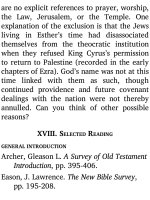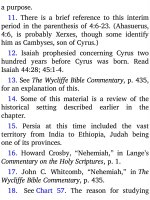Jensens survey of the old testament adam 105
Bạn đang xem bản rút gọn của tài liệu. Xem và tải ngay bản đầy đủ của tài liệu tại đây (133.4 KB, 4 trang )
books)
English Bible (A.D.): 1,2 Samuel; 1,2 Kings
(four books)
The intimate structural connection of 2
Samuel with 1 Samuel is shown by the
accompanying outline. Note especially that
the last half of 1 Samuel and the rst
chapter of 2 Samuel are part of one section
in the outline for the simple reason that the
story of Saul does not end until chapter 1 of
2 Samuel.
FIRST AND SECOND SAMUEL
C. AUTHOR AND DATE
It is di cult to identify the author (or
authors). Various suggestions of authorship
or coauthorship include Abiathar, an
attendant of David; Nathan and Gad (cf. 1
Chron 29:29); and pupils from Samuel’s
school of the prophets. The detailed and
vivid account of the happenings, with which
these books abound, indicates that most of
the narrative was written by men living at
the time these things occurred rather than at
a much later date.
The fact of joint authorship does not take
away from the unity of the books as to
theme. Concerning all the writings of
Scripture, one must continually recognize
the supernatural moving of the Holy Spirit
in the hearts and minds of the human
writers, whoever and however many they
were, to compose the holy writings.
If Samuel was one of the authors, he could
only have narrated the events that preceded
his death (which is recorded in 1 Sam 25).2
He would have done his writing sometime
between 1025 and 900
B.C.
D. THE THREE LEADING CHARACTERS OF
SAMUEL
1 AND 2
1. Samuel. The name Samuel is from a
Hebrew word which has been variously
translated as: “the name of God,” “his name
is God,” “his name is mighty,” or “heard of
God.”
One is not surprised that the Jews have
esteemed Samuel second to Moses among
their leaders. The psalmist (Psalm 99:6), and
God speaking to Jeremiah (Jer 15:1),
classi ed Samuel with Moses as an
interceding priest. Samuel held the honor of
being the last of the judges (1 Sam 7:6, 1517) and the rst of the new order of
prophets (1 Sam 3:20; Acts 3:24; 13:20). The
stature of the prophetic o ce during the
years of the kingdoms can be traced back to
Samuel’s life and ministry. He probably was
the founder of a school of prophets (cf. 1
Sam 10:5).3
2. Saul. Saul (Heb., Sa-ul, “asked,” i.e., of
God) was the rst king of Israel; son of Kish,
of the tribe of Benjamin. He was a choice
young man in the prime of life when he was
placed on the throne. He was a physical
“giant” (1 Sam 10:23), industrious,
generous, honest, and modest. God chose
him to institute Israel’s monarchy, but three
times during his reign he disquali ed
himself from the high o ce. The story of
Saul (1 Sam 9-31) is one of the most
pathetic accounts of God’s servants. J.
Barton Payne cites four degenerations in
Saul’s experience:4
GOOD POINTS
DEGENERATED INTO
striking appearance, 9:2
pride, 18:8
initiative, 11:7
rebellion, 20:31
bravery, 13:3
recklessness, 14:24
patriotic Spirit-filling, 11:6
demon possession, 16:14









